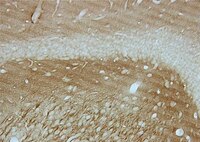AG960 Sigma-AldrichTau-441, recombinant human
Recommended Products
Overview
| Replacement Information |
|---|
| References |
|---|
| Product Information | |
|---|---|
| Presentation | White lyophilized powder. Resuspend in water at a concentration of 1 mg/mL. This will give you a final of 50 mM MES, pH 6.8, 100 mM NaCl and 0.5 mM EGTA. |
| Quality Level | MQ100 |
| Applications |
|---|
| Physicochemical Information |
|---|
| Dimensions |
|---|
| Materials Information |
|---|
| Toxicological Information |
|---|
| Safety Information according to GHS |
|---|
| Safety Information |
|---|
| Packaging Information | |
|---|---|
| Material Size | 50 µg |
| Transport Information |
|---|
| Supplemental Information |
|---|
| Specifications |
|---|
| Global Trade Item Number | |
|---|---|
| Catalog Number | GTIN |
| AG960 | 04053252673696 |
Documentation
Tau-441, recombinant human SDS
| Title |
|---|
Tau-441, recombinant human Certificates of Analysis
| Title | Lot Number |
|---|---|
| HUMAN TAU-441 | 2475588 |
| HUMAN TAU-441 (Recombinant, E. coli) - 2145062 | 2145062 |
| HUMAN TAU-441 (Recombinant, E. coli) | 3137753 |
| HUMAN TAU-441 (Recombinant, E. coli) | 3140985 |
| HUMAN TAU-441 (Recombinant, E. coli) | 3071629 |
| HUMAN TAU-441 (Recombinant, E. coli) | 2886833 |
| HUMAN TAU-441 (Recombinant, E. coli) | 2900145 |
| HUMAN TAU-441 (Recombinant, E. coli) | 3112602 |
| HUMAN TAU-441 (Recombinant, E. coli) - 2088952 | 2088952 |
| HUMAN TAU-441 (Recombinant, E. coli) - 2194042 | 2194042 |








